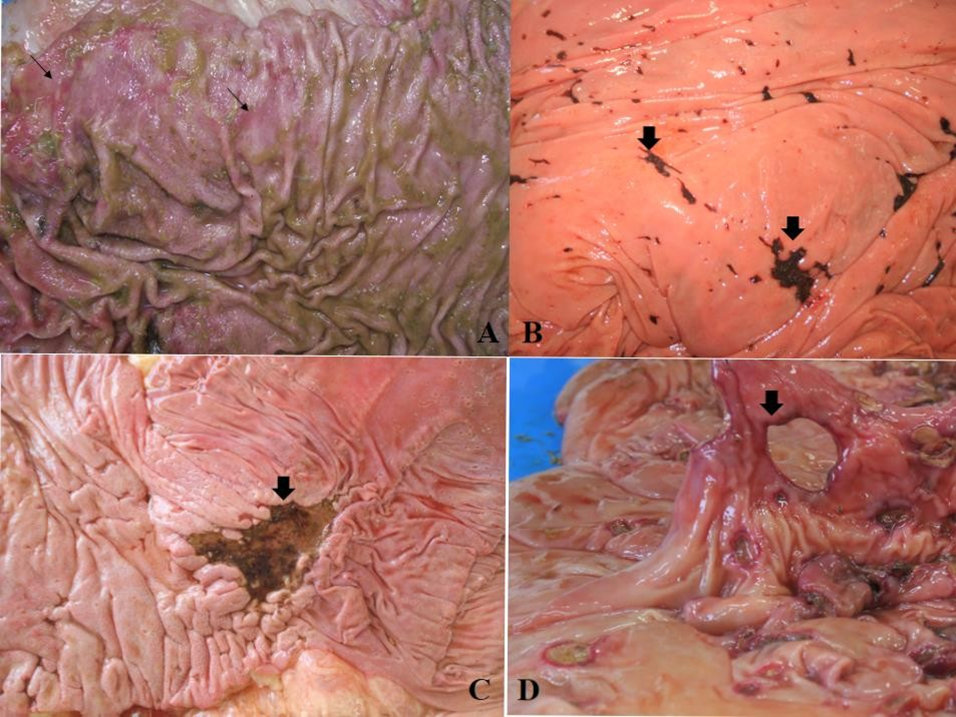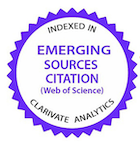Achados epidemiológicos e anatomopatológicos de úlceras do abomaso tipo 1 e 2 em bovinos com diferentes comorbidades primárias
DOI:
https://doi.org/10.1590/1809-6891v24e-74772EResumo
Objetivou-se estudar os achados epidemiológico e anatomopatológico de úlceras do abomaso tipo 1 e 2 em bovinos com diferentes comorbidades primárias. Um total de 201 animais; 40/201 (20%) eram bovinos jovens com idade inferior a dois anos e 161/201 (80%) eram bovinos adultos com idade superior a dois anos, os quais foram internados para atendimento clínico 152/201 (75,62%), 19/201 (9,45%) obstétrico, 17/201 (8,46%) para atendimento clínico-cirúrgico e 13/201 (6,47%) para diagnóstico anatomopatológico, sendo eutanasiados ou tiveram morte natural. O diagnóstico das úlceras foi baseado no exame post-mortem (análise macroscópica e histopatológica). O exame histopatológico foi realizado em 201 fragmentos de úlceras e classificado como tipo 1 ou do tipo 2. Destes, 193/201 (96,01%) corresponderam a úlceras tipo 1, das quais, 12/193 (5,97%) corresponderam a lesões subtipo 1a, 101/193 (50,25%) a subtipo 1b, 77/193 (38,31%) a subtipo 1c, 03/193 (1,49%) ao subtipo 1d, enquanto 08/201 (3,98%) foram úlceras tipo 2. As úlceras foram caracterizadas por processo inflamatório focal, focalmente extenso, multifocais ou difusos, principalmente por células mononucleares. Abomasite associada à mucosa ulcerada foi encontrada em 160/201 (79,60%). Em 26/201 (12,93%) a abomasite apresentava focos difusos de proliferação linfocítica multifocal por linfócitos atípicos. As comorbidades digestivas e reprodutivas foram observadas com maior frequência em bovinos com úlceras tipo 1 ou tipo 2. As úlceras focais subtipo 1b e úlceras multifocais subtipo 1a e 1b foram mais prevalentes. Além da presença de comorbidades, a maioria dos casos ocorrerem no período seco, associados à alimentação com maiores aportes de concentrados e silagens.
Palavras Chave: bovinos leiteiros; doenças do abomaso; melena; úlcera; histopatologia.
Downloads
Referências
Constable PD, Hinchcliff KW, Done SH, & Grünberg W. Veterinary Medicine: A textbook of the diseases of cattle, horses, sheep, pigs, and goats. 11a. ed. Elsevier. St. Louis, Missouri. 2017. p.2356.
Fubini SL, Yeager AE, & Divers TJ. Noninfectious Diseases of the Gastrointestinal Tract. In: Peek SF, &. Divers TJ. (Eds). Rebhun’s Diseases of Dairy Cattle: 3a. ed. Elsevier. St. Louis, Missouri; 2018. p. 168-245.
Francoz D, & Guard CL. Abomasal Ulcers. In: Bradford PS, David CVM, & Nicola P. Large Animal Internal Medicine. 6a ed. Elsevier, St. Louis, Missouri; 2020. p. 889–893.
Jelinski MD, Ribble CS, Chirino-Trejo M, Clark EG, & Janzen ED. The relationship between the presence of Helicobacter pylori, Clostridium perfringens type A, Campylobacter spp, or fungi and fatal abomasal ulcers in unweaned beef calves. Canadan. Vet. J. 1995;36:379-382.
Souza LM, Assis RN, Rego RO, Santos JF, Coutinho LT, Souza JCA, Mendonça CL, Afonso JAB, & Souto RJC. Achados clínicos, laboratoriais e anatomopatológicos de bezerros com úlceras de abomaso. Ciênc. Vet. Tróp. 2017;19(3):20-28.
Whitlock RH. Bovine stomach diseases. In: Anderson NV. (Ed). Veterinary Gastroenterology, Lea and Febiger, Philadelphia; 1980. p.425-428
Smith DF, Munson L, & Erb HN. Abomasal ulcer disease in adult dairy cattle. Cornell Vet. 1983;73(3):213–224.
Aukema JJ, & Breukink HJ. Abomasal ulcer in adult cattle with fatal haemorrhage. Cornell. Vet. 1974;64(2):303–317.
Palmer JE, & Whitlock RH. Bleeding abomasal ulcers in adult dairy cattle. J. Am. Vet. Med. Assoc. 1983;183(4):448–451.
Braun U, Gerspach C, Nuss K, Hässiga M, Hilbeb M, & Reif C. Clinical and laboratory findings, treatment and outcome in 145 cows with type-2 abomasal ulcer. Res. Vet. Sci. 2019;124:366–374.
Braun U, Gerspach C, Hilbe M, Devaux DJ, & Reif C. Clinical and laboratory findings in 60 cows with type-3 abomasal ulcer. Schweiz. Arch. Tierh. 2019;161(9):523–531.
Braun U, Reif C, Nuss K, Hilbe M., & Gerspach C. Clinical, laboratory and ultrasonographic findings in 87 cows with type- 4 abomasal ulcer. BMC. Vet. Res. 2019;15(1):100.
Braun U, Reif C, Hilbe M, & Gerspach C. Type-5 abomasal ulcer and omental bursitis in 14 cows. Act. Vet. Scand. 2020;62(1):4.
Braun U, Eicher R, & Ehrensperger F. Type 1 Abomasal Ulcers in Dairy Cattle. J. Vet. Med. 1991; 38(1–10):357–366.
Hund A, Beer T, & Wittek T. Abomasal ulcers in slaughtered cattle in Austria. Tierarztl. Prax. Ausg. G. Grosstiere. Nutztiere. 2016;44(5):279–285.
Ducharme NG, Desrochers A, Fubini SL, Pease AP, Mizer LA, Walker W, Trent AM, Roy JP, Rousseau M, Radcliffe RM, & Steiner A. Surgery of the bovine digestive system. In: Fubini SL, & Ducharme NG. (Eds). Farm Animal Surgery. 2a ed. Elsevier. St. Louis, Missouri; 2017. p.223-343.
Braun U, Gerspach C, Reif C, Hilbe M, & Nuss K. Clinical, laboratory and ultrasonographic findings in 94 cows with type- 1 abomasal ulcer. Schweizer. Arch. Tierh. 2020;162(4):235–244.
Ok M, Sem I, Turgut K, & Irmak K. Plasma gastrin activity and the diagnosis of bleeding abomasal ulcers in cattle. J. Vet. Med. 2001;48(9):563–568.
Mesarič M. Role of serum pepsinogen in detecting cows with abomasal ulcer. Vet. Arhiv. 2005;75(2):111–118.
Marshall TS. Abomasal Ulceration and Tympany of Calves. Vet. Clin. North Am. Food Anim. Pract. 2009; 25(1):209–220.
Hussain SA, Uppal SK, & Sood NK. Clinicopathological diagnosis of type-I abomasal ulceration in cattle and buffaloes. Indian. J. Vet. Pathol. 2015;39(3):239.
Silva Filho AP, Afonso JAB, Souza JCA, Dantas AC, Costa NA, & Mendonça CL. Achados clínicos de bovinos com úlcera de abomaso. Vet. Zootec. 2012;19(2):196–206.
Munch SL, Nielsen SS, Krogh MA, & Capion N. Prevalence of abomasal lesions in Danish Holstein cows at the time of slaughter. J. Dairy. Sci. 2019;102(6):5403–5409.
Nielsen SS, Krogh MA, Munch SL, & Capion N. Effect of non-perforating abomasal lesions on reproductive performance, milk yield and carcass weight at slaughter in Danish Holstein cows. Prev. Vet. Med. 2019;167(2):101–107.
Hund A, & Wittek T. Labmagengeschwüre beim Rind. Tierarztl. Prax. Ausg. G. Grosstiere. Nutztiere. 2017;45(02):121–128.
Luna SPL, & Teixeira MW. Eutanásia: considerações éticas e indicações técnicas. Revta. CFMV. 2007;13(41): 60-69.
Jensen R, Pierson RE, Braddy PM, Saari DA, Benitez A, Lauerman LH, Horton DP, & McChesney AE. Abomasal erosions in feedlot cattle. Am. J. Vet. Res. 1992;53(1):110-115.
Braun U, Bretscher R, & Gerber D. Bleeding abomasal ulcers in dairy cows. Vet. Rec. 1991;129(13):279-284.
Jelinski MD, Ribble CS, Campbell JR, Janzen ED. Investigating the relationship between abomasal hairballs and perforating abomasal ulcers in unweaned beef calves. Canadian Vet. J. 1996; 37(37):23-26.
Akbari H, Shahbazfar AA, Araghi-Sooreh A, Hassan-Nejad H, Zangisheh M, & Taheri M. Macroscopic and pathologic evaluation of cattle abomasal ulcers in Tabriz industrial slaughterhouse. Vet. Res. Biol. Prod. 2017;05(177):192-202.
Palmer J, Whitlock R. Perforated abomasal ulcers in adult dairy cows. J Am Vet Med Assoc 1984; 184: 171–174.
Hussain SA, Uppal SK, & Sood NK. The prevalence, frequency and topographic distribution of type 1-abomasal ulcers in water buffalo (bubalus bubalis): A case control study. Vet. Arhiv. 2019; 89(3): 317-330.
Tajik J, Khodakaram AT, Heidari M, & Babazadeh M. Prevalence, histopathological, and some epidemiological aspects of abomasal ulcers in water buffalo (Bubalus bubalis) in Iran. Comp. Clin. Path. 2013; 22(2):271-275.
Uzal FA, Plattner BL, & Hostetter JM. Alimentary System. In: Maxie MG. (Ed) Jubb, Kennedy, and Palmer’s Pathology of Domestic animals. Vol. 2. 6a. ed. Elsevier, St Louis, Missouri. 2016; p.1-257.
Murray MJ. Equine model of inducing ulceration in alimentary squamous epithelial mucosa. Dig. Dis. Sci. 1994; 39(12):2530-2535.
Jassim A, Yousif AAR, & Kshash QH. Study on Abomasal Ulcer in Sheep in Iraq. Int. J. Adv. Res. 2014;2(1):342-349.

Downloads
Publicado
Como Citar
Edição
Seção
Licença
Copyright (c) 2023 Ciência Animal Brasileira / Brazilian Animal Science

Este trabalho está licenciado sob uma licença Creative Commons Attribution 4.0 International License.
Autores que publicam nesta revista concordam com os seguintes termos:
- Autores mantém os direitos autorais e concedem à revista o direito de primeira publicação, com o trabalho simultaneamente licenciado sob a Licença Creative Commons Attribution que permite o compartilhamento do trabalho com reconhecimento da autoria e publicação inicial nesta revista.
- Autores têm autorização para assumir contratos adicionais separadamente, para distribuição não-exclusiva da versão do trabalho publicada nesta revista (ex.: publicar em repositório institucional ou como capítulo de livro), com reconhecimento de autoria e publicação inicial nesta revista.
- Autores têm permissão e são estimulados a publicar e distribuir seu trabalho online (ex.: em repositórios institucionais ou na sua página pessoal) a qualquer ponto antes ou durante o processo editorial, já que isso pode gerar alterações produtivas, bem como aumentar o impacto e a citação do trabalho publicado (Veja O Efeito do Acesso Livre).






























